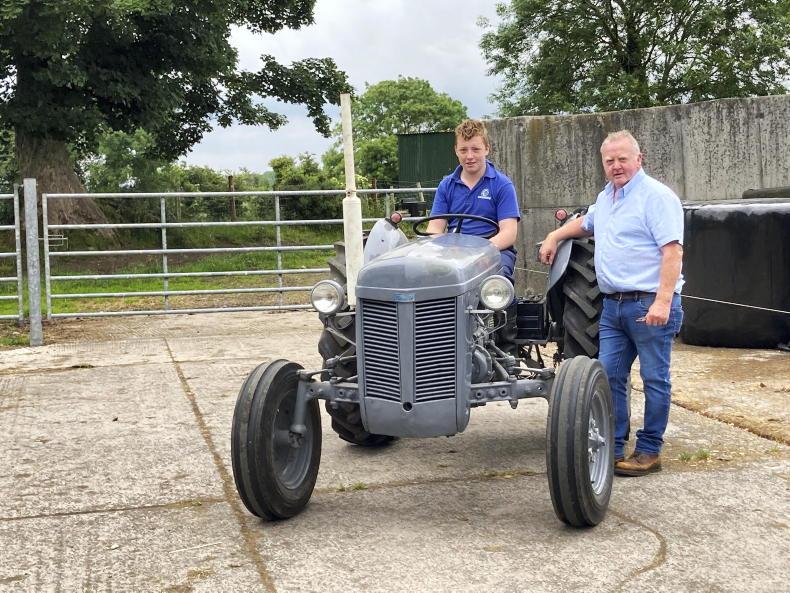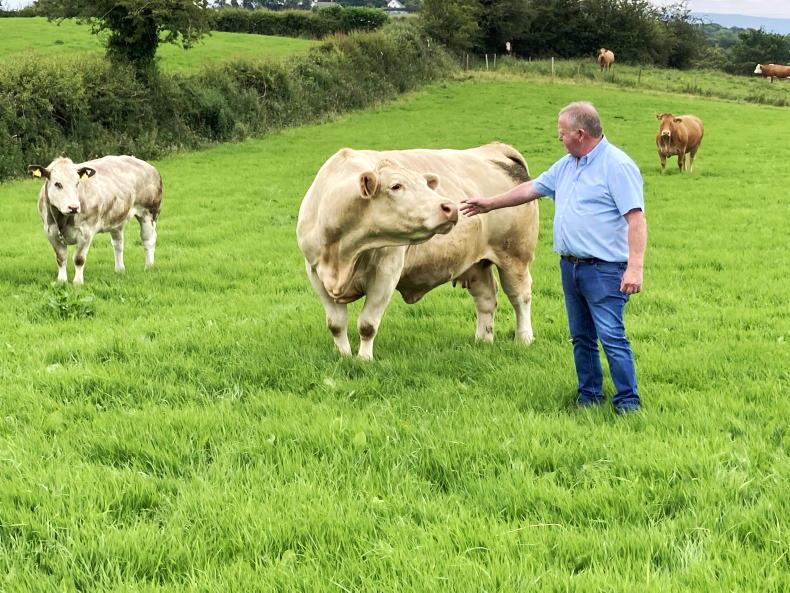Like most suckler farmers in the west of Ireland, Padraig Jinks juggles farming alongside another job. He is a self-employed painter, mainly working during the summer months. This allows Padraig to work flexible hours to suit himself around the farm and he can always be available for a sudden change in farm work.
“I love painting, it really fits in with farming and gives me an income when money can be tight in summer months.
“Help on any farm is a huge factor and I am lucky to have my partner, Siobhán, as well as my brothers, sisters nieces and nephews.”
Padraig’s farm was originally bought by his parents in 1956 when they returned from the US to settle down and have a family. Owned land comprises of 60 acres and when this is added to leased land, Padraig is farming a total of 90 acres, of which 10 acres floods along the river Arrow.
He farms 35 top-quality suckler cows and breeds his own replacement heifers. He sells the other calves as weanlings in Ballymote Mart.
Padraig operates a split-calving system with half the herd calving in the autumn and the other half calving in the spring.
“This eases the workload and allows me to have two tight calving spells with no pressure for space at one time in sheds.”
Padraig uses 100% AI to achieve such tight calving, which is carried out by his friend and AI technician Jacqueline Callaghan.

Padraig with his nephew Shane and his recently restored Ferguson 20 Diesel tractor.
Weanlings are sold in spring and autumn, with autumn-calved weanlings sold in mid-April to aim at the grass buyers and spring-born weanlings sold in October.
Bull weanlings are sold at 320kg in the spring and 400kg in the autumn for an average price of €900 in spring and €1,000 in the autumn. Heifer weanlings usually sell at 300kg in the spring for an average of €800 and 350kg in the autumn for an average of €900.
Prior to Covid-19, Padraig attended and hosted farm walks for a Knowledge Transfer (KT) group. He found the walks very beneficial, as he could hear what other farmers had problems with and the solutions they came up with. “Advice is always great to get and sometimes, as farmers, we don’t take enough of it.”
Off-farm interests
Padraig enjoys a social life which he has developed through his work painting, as well as being a member of the Riverstown Show committee.
He helps to run the cattle and sheep section of the show each year.
Local agricultural shows are a huge part of any community in rural Ireland, and they take effort to pull off, but these shows give farmers a place to socialise as farming can prove isolating at times.
“The whole community engages to make the show happen, from local people to businesses and, most importantly, the sponsors,” Padraig added.
“The committee is so hard-working. Without such a good team, the show would find it hard to go ahead.”
Padraig said that the show gets huge support from the local Aurivo Co-op with gates and posts on the day.

Padraig with one of his cull cows, which will be going to Ballymote mart shortly.
The future
The new CAP will affect Padraig initially, but he is hopeful that there will be an environmental scheme to aid his initial loss.
Padraig loves the environment and nature, which was evident from walking around his farm with blooming hedges suitable for all aspects of nature.
“I don’t like cutting hedges down but laying a hedge to make it thicker and more of a habitat is great for nature.”
Padraig also told us how he feels farmers should be aided in the planting of new hedges as well as some funding for hedgerow management for practices such as laying hedges.
Benefits of something like this can be seen from the AEOS scheme, which some farmers participated in before GLAS.
Renovation
With a love for painting and renovating as well as farming, Padraig hopes that the Government may provide funding for the renovation of old farm buildings and houses.
“I feel there is a huge market for houses for rent or Airbnb in rural Ireland. Some farmers could make a reasonable income from letting out their old farmhouses if they could afford to renovate them.”
Padraig also outlined the benefit this would give the community through more work for builders and the possible tourism boost post-renovation.
Change
The biggest change for Padraig in the future will be a reduction in cow numbers, which he has started in recent months.
Padraig aims to calve 30 cows in the future.
This reduction may seem relatively small, as he said himself, but it is inevitable that some of the environmental schemes will want the national herd reduced anyway.
“I started culling harder in the last few weeks with cow prices so strong and I got on well with a few cows in Ballymote, with the worst cow selling for €1,840.”
Padraig feels that suckler beef from the west of Ireland needs to be marketed as a unique product, which is not at the moment. If something isn’t done soon, suckler cow numbers will keep diminishing.
Farm facts
Farming system: suckler to weanling beef.Cow numbers: 35.Breeds: Limousin/Simmental/Charolais.Quotable quote: “There is nothing more enjoyable than seeing a family head away from our local show with rosettes at the end of the day. It makes the hard work worthwhile.”
Like most suckler farmers in the west of Ireland, Padraig Jinks juggles farming alongside another job. He is a self-employed painter, mainly working during the summer months. This allows Padraig to work flexible hours to suit himself around the farm and he can always be available for a sudden change in farm work.
“I love painting, it really fits in with farming and gives me an income when money can be tight in summer months.
“Help on any farm is a huge factor and I am lucky to have my partner, Siobhán, as well as my brothers, sisters nieces and nephews.”
Padraig’s farm was originally bought by his parents in 1956 when they returned from the US to settle down and have a family. Owned land comprises of 60 acres and when this is added to leased land, Padraig is farming a total of 90 acres, of which 10 acres floods along the river Arrow.
He farms 35 top-quality suckler cows and breeds his own replacement heifers. He sells the other calves as weanlings in Ballymote Mart.
Padraig operates a split-calving system with half the herd calving in the autumn and the other half calving in the spring.
“This eases the workload and allows me to have two tight calving spells with no pressure for space at one time in sheds.”
Padraig uses 100% AI to achieve such tight calving, which is carried out by his friend and AI technician Jacqueline Callaghan.

Padraig with his nephew Shane and his recently restored Ferguson 20 Diesel tractor.
Weanlings are sold in spring and autumn, with autumn-calved weanlings sold in mid-April to aim at the grass buyers and spring-born weanlings sold in October.
Bull weanlings are sold at 320kg in the spring and 400kg in the autumn for an average price of €900 in spring and €1,000 in the autumn. Heifer weanlings usually sell at 300kg in the spring for an average of €800 and 350kg in the autumn for an average of €900.
Prior to Covid-19, Padraig attended and hosted farm walks for a Knowledge Transfer (KT) group. He found the walks very beneficial, as he could hear what other farmers had problems with and the solutions they came up with. “Advice is always great to get and sometimes, as farmers, we don’t take enough of it.”
Off-farm interests
Padraig enjoys a social life which he has developed through his work painting, as well as being a member of the Riverstown Show committee.
He helps to run the cattle and sheep section of the show each year.
Local agricultural shows are a huge part of any community in rural Ireland, and they take effort to pull off, but these shows give farmers a place to socialise as farming can prove isolating at times.
“The whole community engages to make the show happen, from local people to businesses and, most importantly, the sponsors,” Padraig added.
“The committee is so hard-working. Without such a good team, the show would find it hard to go ahead.”
Padraig said that the show gets huge support from the local Aurivo Co-op with gates and posts on the day.

Padraig with one of his cull cows, which will be going to Ballymote mart shortly.
The future
The new CAP will affect Padraig initially, but he is hopeful that there will be an environmental scheme to aid his initial loss.
Padraig loves the environment and nature, which was evident from walking around his farm with blooming hedges suitable for all aspects of nature.
“I don’t like cutting hedges down but laying a hedge to make it thicker and more of a habitat is great for nature.”
Padraig also told us how he feels farmers should be aided in the planting of new hedges as well as some funding for hedgerow management for practices such as laying hedges.
Benefits of something like this can be seen from the AEOS scheme, which some farmers participated in before GLAS.
Renovation
With a love for painting and renovating as well as farming, Padraig hopes that the Government may provide funding for the renovation of old farm buildings and houses.
“I feel there is a huge market for houses for rent or Airbnb in rural Ireland. Some farmers could make a reasonable income from letting out their old farmhouses if they could afford to renovate them.”
Padraig also outlined the benefit this would give the community through more work for builders and the possible tourism boost post-renovation.
Change
The biggest change for Padraig in the future will be a reduction in cow numbers, which he has started in recent months.
Padraig aims to calve 30 cows in the future.
This reduction may seem relatively small, as he said himself, but it is inevitable that some of the environmental schemes will want the national herd reduced anyway.
“I started culling harder in the last few weeks with cow prices so strong and I got on well with a few cows in Ballymote, with the worst cow selling for €1,840.”
Padraig feels that suckler beef from the west of Ireland needs to be marketed as a unique product, which is not at the moment. If something isn’t done soon, suckler cow numbers will keep diminishing.
Farm facts
Farming system: suckler to weanling beef.Cow numbers: 35.Breeds: Limousin/Simmental/Charolais.Quotable quote: “There is nothing more enjoyable than seeing a family head away from our local show with rosettes at the end of the day. It makes the hard work worthwhile.” 







 This is a subscriber-only article
This is a subscriber-only article











SHARING OPTIONS: